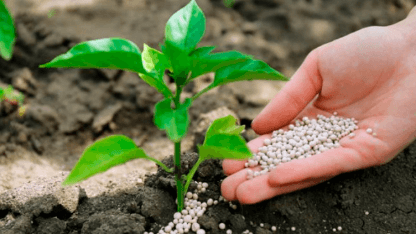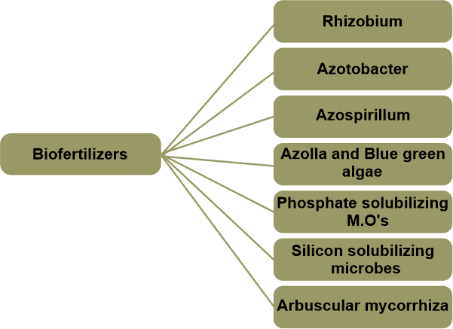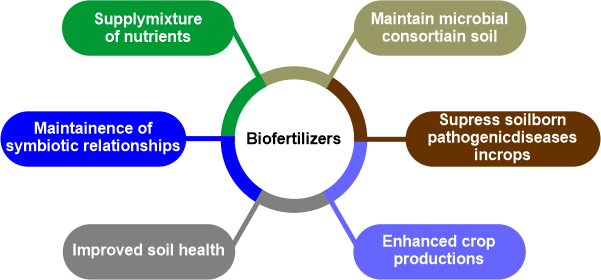Advantages and Disadvantages of BiofertilizersBy enhancing the delivery of vital nutrients to plants, biofertilizers, which are substances containing microorganisms, aid in stimulating the development of plants and trees. It is made up of living things like bacteria, blue-green algae, and mycorrhizal fungi. For the benefit of the plant, mycorrhizal fungi preferentially remove minerals from organic materials, whereas cyanobacteria are distinguished by their ability to fix nitrogen. The process of turning di-nitrogen atoms into ammonia is known as nitrogen fixation. As an illustration, certain bacteria metabolize nitrogen into ammonia. As a result, plants may now get nitrogen. 
By boosting the nutrient supply, increasing root volume or root area, and enhancing the plant's ability to absorb nutrients, biofertilizers, which are natural products containing living microbes, can enhance growth when applied to seeds, plant surfaces, or soil. By populating the rhizosphere and making the nutrients freely available to plant root hairs, biofertilizers, which include a range of bacteria, can improve plant nutrient absorption. The composition, cost-effectiveness, and environmental friendliness of biofertilizers are widely established. These are potent substitutes for risky synthetic fertilizers. This article discusses different microbial biofertilizers, including mutually supportive and free-living nitrogen-fixers, phosphorus-solubilizers, and mobilizers, as well as the formulations and applications of a few commercially available biofertilizers toward organic farming and recent efforts to develop next-generation biofertilizers. Types of biofertilizers1. Symbiotic Nitrogen-Fixing BacteriumRhizobium is one of the essential symbiotic bacteria that fix nitrogen. Here, bacteria look for cover and eat plants. They assist by giving the plants fixed nitrogen in exchange. The productivity of agricultural plants and, hence, food production, is restricted by access to fixed or readily available types of nitrogen. The cost of producing nitrogenous fertilizer is now a major barrier to the effective development of many crops in the industrialized world. Both rich and developing nations stand to gain significantly from lowering their reliance on nitrogenous fertilizers in agriculture, and there is a great deal of interest in research into biological nitrogen fixing and the possibility of growing its significance in an agricultural environment. The transformation of atmospheric N2 into NH3, which is a form that plants may utilize, is known as biological nitrogen fixation. However, eukaryotes do not engage in the process; it is exclusive to bacteria and archaea. In a mutualistic connection, plants provide bacteria with habitat and fixed carbon in return for fixed nitrogen in symbiotic nitrogen fixation. There is a lot of interest in determining if comparable symbioses may arise in nonlegumes, which generate the majority of human food, as this mechanism is primarily limited to legumes in agroecosystems. Now that we have a solid grasp of how biological nitrogen fixation works on a fundamental level, we might consider employing synthetic biology techniques to build symbiotic partnerships. In the framework of a blueprint for applying synthetic biology to extend symbiotic n2 fixation to a wider variety of agricultural plants, this minireview emphasises the basic advancements in our knowledge of biological nitrogen fixation. 2. Loose association of Nitrogen-Fixing BacteriaAzospirillum is a nitrogen-fixing bacterium that coexists with higher plants but does not form close bonds with them. Rhizosphere association is a common name for it because these bacteria gather plant exudate and use it as food. The phrase "associative mutualism" refers to this process. 
3. Symbiotic Nitrogen-Fixing CyanobacteriaCyanobacteria or blue-green algae form a symbiotic relationship with several plants. Among the cyanobacteria that fix nitrogen are liverworts, cycad roots, ferns, and lichens. Anabaena can be discovered in the fern's leaf cavities. It is in charge of fixing nitrogen. As the fern plants deteriorate, they provide nutrients that the rice plants may use. The fern Azolla pinnate lives in rice fields, however, it does not control the plant's development. Nostoc is a genus of filamentous, nitrogen-fixing cyanobacteria that thrive in both terrestrial and aquatic settings and produce microscopic or macroscopic colonies. Additionally, Nostoc species coexist in symbiotic relationships with ferns, liverworts, and also the angiosperm Gunnera. Nostoc punctiforme is an endosymbiotic member of the fungal Geosiphon pyriformis. Nostoc species have spherical, cylinder, or oval cells that produce unbranched filaments. Akinetes and heterocysts, which are thick-walled, specialized N-fixing cells, may both be present in the filaments (trichomes: the thick-walled cell which functions as a resting cell). Colonies of Nostoc spp. take on a variety of distinctive forms, dimensions, aromas, textures, and hues. These colonies may grow fairly huge if there is enough water available. Because of their ability to endure desiccation for extended periods (years), several Nostoc species have thrived in a variety of terrestrial settings. Physiological processes gradually cease when the Nostoc colonies dry up. They recover fast after being rewetted. Nostoc spp. can be utilized as natural nitrogen fertilizers in rice fields and for soil restoration. It has been demonstrated that Nostoc muscorum accumulates polyhydroxy butyrate, a precursor to natural polymers. 4. Free-living bacteria that fix NitrogenThey are nitrogen-fixing soil microorganisms that live freely. They include saprotrophic anaerobes such as Azotobacter, Clostridium beijerinckii, etc. It describes the method through which heterotrophic bacteria on the surfaces of nearby roots fix nitrogen, serving as a significant supply of nitrogen in several terrestrial ecosystems. Acting as an alternative to artificial fertilizers, it also has a significant impact on agriculture. The most often utilised biofertilizers are Rhizobium and Azospirillum. The same group that accords fundamental importance to nitrogen fixation includes free-living nitrogen-fixing microorganisms. Cyanobacteria, Anabaena, and other microbes with comparable traits are among the most prevalent of them. As opposed to symbiotic nitrogen fixations, free-living nitrogen fixation is distinct from other various and dynamic environments. Due to this capability, it is sometimes difficult to evaluate identifying restrictions for actual application in agricultural and other sectors. Mutualistic and unrestricted nitrogen-fixing bacteria are often involved in the process, which has an impact on the free-living nitrogen fixation necessary for crop production and other uses. It may also be viewed as a subset of symbiotic nitrogen fixation in some circumstances, which may explain why it shares environmental traits with that process. In light of this, it may be claimed that naturally occurring microorganisms fix nitrogen. Free-living nitrogen-fixing bacteria have several uses and are an important part of nature. These microbes do not need to form symbiotic interactions with plants to exist. It is also essential since some plant species do not develop symbiotic partnerships with bacteria that fix nitrogen. When compared to the total number of macrobiotic organisms in the soil, the concentration of free-living nitrogen-fixing bacteria is relatively low. Even when the soil is used for agricultural reasons, one of their major contributions is to help create a soil that really can differentiate nitrogen and thin air. This is especially important for crops like wheat and maize that do not have symbiotic interactions with microbes that fix nitrogen in the soil. Free-living nitrogen-fixing bacteria are crucial in determining the overall output of agriculture. This is accomplished by giving plants what they require in terms of nutrition, which they trade for exudates that they provide the soil. This leads to the conclusion that a significant portion of biological activities depends on free-living, nitrogen-fixing bacteria. Importance of BiofertilizersTo restore the soil's fertility, biofertilizers are necessary. The use of chemical fertilizers over a lengthy period damages the soil and reduces crop output. On the other side, biofertilizers improve the soil's ability to hold water while also adding vital minerals like nitrogen, vitamins, and proteins. Since they are a natural source of fertilizer, agriculture uses them extensively. Rice crops are planted using the seedling root dip technique, which involves placing the seedlings in a layer of water for eight to ten hours. Seed treatment: During this step, fertilizer mixtures including phosphorus and nitrogen are applied to the seeds. They are dried before being sown as soon as possible. Treatment of the soil: The biofertilizer and compost fertilizer Blend is stored overnight and applied to the Soil the next Day. Before planting the seedlings, this therapy is administered. Biofertilizers promote crop growth and boost plant output by 20-30%. 
Even in semi-arid environments, they are efficient. These biofertilizers are effective even in tough environments where a dry climate and little rainfall are the norms. By enhancing soil characteristics including smoothness, bulk density, and water-holding capacity, they health of the soil. Providing plants with a rich environment for growth and increased harvests. Biofertilizers prevent dangerous germs from surviving in soil. by releasing several compounds that control dangerous bacteria. In addition to producing critical nutrients like nitrogen, potassium, and phosphorus, they also release several growth-promoting compounds like cytokinins and gibberellic acid into the soil, which improves soil fertility. Once a farmer has enough information and expertise regarding how this process works, he may manufacture biofertilizers close to his farm by inoculating bacterial cultures, which is another key component of biofertilizers. They don't contaminate the environment. This implies that unlike synthetic fertilizers, which permanently degrade soil quality, organic fertilizers do not leave behind any residues or harmful elements when applied to the soil. Biofertilizers are therefore more significant in techniques for sustainable agriculture. Biofertilizers are therefore more dependable and demonstrate more relevance for a secure future. How should one use biofertilizer and achieve good results?
Advantages of biofertilizers1. Soil enrichment By creating soil rich in nutrients, they assist in obtaining crops with a high yield. 2. More suitable than synthetic fertilizers Chemical fertilizers change the soil's natural nutritional composition, whereas biofertilizers keep it the same as before. 3. Non-toxic to plants Plant development can be accelerated by using biofertilizers, which include natural ingredients that do not hurt plants. 4. Beneficial for soil microorganisms The soil can continue to harbour beneficial microorganisms required for plant development. Protects the soil's natural fertility: Chemical-free Soil will keep its natural fertility, which is good for both the environment and the plants. Because biofertilizers eliminate the toxic elements in the soil that cause plant illnesses, plants are better suited. By employing biofertilizers, plants can also be shielded against famine and other harsh situations. 5. Economic Farmers can easily create or collect biofertilizers, which are significantly more cost-effective. 6. Eco-friendly They respect the environment and guard it against contaminants. 7. Sustainability Biofertilizers are largely made from microbial and plant sources. Algae and biogas production both produce significant amounts of biological material that may be utilised to create biofertilizers. 8. Affordability Adding biofertilizer is a cost-effective alternative since it allows farmers to use less traditional fertilizers and pesticides. 9. Better soil Your plants receive air nitrogen directly from the microbes in biofertilizers. An improved framework for binding soil particles together is produced by the expansion of exterior hyphae. Biofertilizers will increase ventilation and water infiltration while reducing compaction. Enhancing the holding power, structure, and texture of the soil. 10. Enhanced plant development and harvest With the help of biofertilizers, our crops can access more nutrients found in the soil. The multiplicity and contribution of the advantageous bacteria we introduce to the soil increase crop output. It has been demonstrated that biofertilizers can boost crop productivity by up to 30%. 11. Biofertilizers that are eco-friendly to the environment are created from organic plant matter Farmers may also cut their usage of chemical fertilizers and pesticides by around 50%, which benefits the environment even more. 12. No negative impact on plant growth or fertility of the soil According to studies, a plant's height can be increased by utilising the liquid fertilizer Rhizobium Azospirillum, Azotobacter. The number of leaves, the length of the shoots, the number of roots, the number of root nodules, and the biochemical components chlorophyll, carbohydrates, protein, and carotenoids. 13. Pathogenic soil bacteria must be managed and prevented It has been demonstrated that biofertilizers encourage the development of plant roots and shield plants against several soil-borne diseases. They reduce the possibility of infections carried by the soil by altering the microecology of the soil and cells that secrete antifungal antibiotics. 14. Boost the root region's beneficial microorganism population In the root area, biofertilizers aid in the survival and multiplication of helpful microorganisms (rhizospheric bacteria). 15. Decreases the need for chemical fertilizers Biofertilizers' microorganisms improve soil structure while re-establishing its organic nutrient cycle. These microbes can also safely break down complicated organic substances into simpler chemicals so that our plants may utilise them. 16. Generally simple to apply While some biofertilizers must be applied using special tools, others are extremely simple to use. 17. Biogas we use to make power The waste products from the manufacturing of biogas may be utilised to create biofertilizers. Disadvantages of biofertilizers1. Increasing crop production slightly Plant growth can rise by up to 30%, however, this isn't going to be as beneficial if the correct circumstances are not there. To increase their crop, most farmers that employ organic fertilizers are still using synthetic fertilizers, only in fewer amounts. 2. Do not replace chemical fertilizers Synthetic fertilizers continue to be the greatest option for farmers when it comes to giving a plant rapid nutrients. These enable a farmer to fix any nutritional shortages in the plants by giving them a specific nutrient right away. 3. For certain crops, specific biofertilizers are necessary Specific fertilizers, especially those containing symbiotic microorganisms, are required for certain crops. 4. The use of non-specific Rhizobium as fertilizer won't promote root nodulation and raise crop yields. 5. Mass microbial production contamination Strict aseptic measures are necessary for the production process. Microbial mass manufacturing contamination is still a prevalent problem. 6. Light sensitive microbes Biofertilizers start to disappear after some time if they are exposed to sunshine. 7. Limited shelf life Biofertilizers need specific handling for long-term storage since they are living. They have a six-month shelf life when kept at room temperature, therefore we must utilise them before then. You have two years to use them up if you store them at a cold temperature. 8. Odour The majority of biofertilizers have a strong, recognizable odour. 9. Loose effectiveness in too-hot or too-dry soils Moisture and warmth are necessary for microbial fertiliser to function effectively. Microbial fertiliser may not be efficient in increasing soil fertility when these conditions are adverse. 10. The effectiveness of microbial fertiliser is influenced by the properties of the soil Other conditions, outside only temperature and moisture, might affect effectiveness. The efficiency of the soil depends on its pH, organic content, and the kinds of microorganisms that are already there. 11. There Is a need for large quantities For organisms that act as biofertilizers to flourish, the soil must have enough nutrients. They are less successful if other microbes contaminate the carrier media or if farmers employ the incorrect strain. |
 For Videos Join Our Youtube Channel: Join Now
For Videos Join Our Youtube Channel: Join Now
Feedback
- Send your Feedback to [email protected]
Help Others, Please Share










